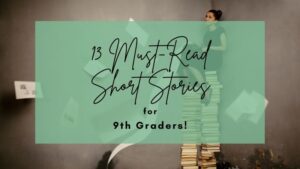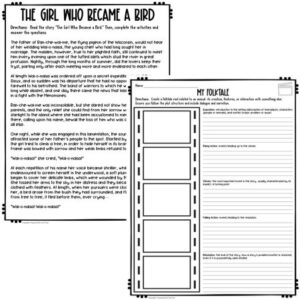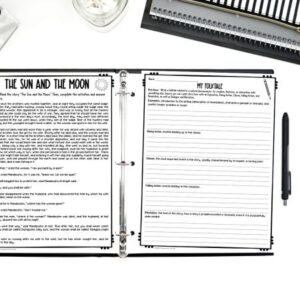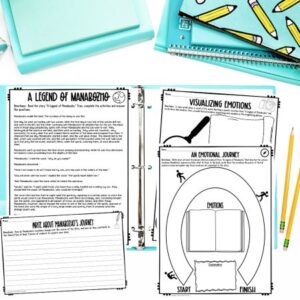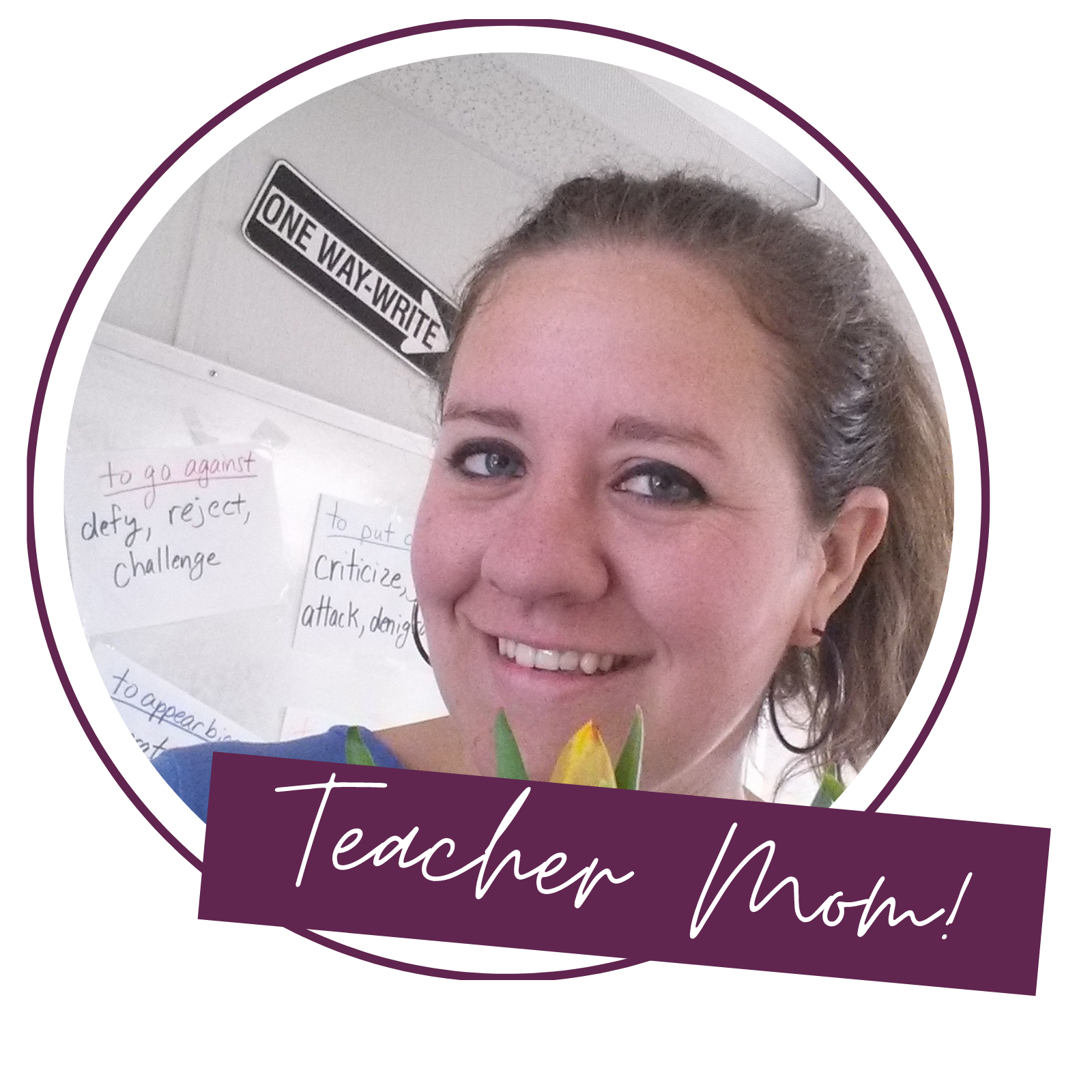I personally enjoy incorporating the classics of the last several centuries, as well as the myths and legends, also known as the folktale story genre, that have captivated people for thousands of years. Because of this perspective, I enjoy using folktale story literature whenever I can! It seems like we easily forget the past in favor of what is hot, new, or trending when it comes to the literature we use in our classrooms.
They are usually easy to integrate into any unit because you can focus on a time period, subject matter, or theme. The options are endless!
Keep reading for 5 Fascinating Folktale Story Passages & Activities To Teach Today!
Need help with Test Prep? Check out this FREE Pack of 3 Test Prep Activities to help students achieve success on standardized tests!
What is a folktale story?
Throughout history, people have relayed stories orally, graphically, or through the printed word. Folktale story texts are everywhere, and they are everywhere because they help to explain the world around us, whether in connection to humans, nature, or the divine.
People have always been intrigued by what is not easily understood, and I enjoy reading stories from other cultures, especially those that answer questions like…
- Where did we come from?
- How did the universe form?
- What makes something good or evil?
- When did animals develop into new species?
- Why do groups of people have certain traits?
There are so many questions, and delving into Native American Literature can be your students’ first foray into Folktale Story Passages!
Need short story ideas for 9th graders? Check out this post!
5 Fascinating Folktale Story Passages & Activities To Teach Today
1. The World on the Turtle’s Back
“The World on the Turtle’s Back,” also known as “The Earth on the Turtle’s Back,” tells the story of the way the Earth was formed. A pregnant woman descends into the lower world of monsters. To help the woman, the turtle becomes her foundation, and dirt/earth is brought up into the turtle. The pregnant woman is safely able to give birth.
Well, she bears twins, one good, one evil. One longs to create, while the other desires the world to stay in its natural state.
After a formidable battle, the good twin wins, and the bad twin is relegated to live as an evil spirit in the realm of death. This version is a more complex one; however, with only two pages of text, your students will be able to finish reading this folktale story in less than ten minutes. Plus, there is so much to teach with this story!
ACTIVITY IDEAS
- Traits Analysis-I like starting out with student-related activities when beginning a text. My favorite is having students identify their own traits (external and internal)! Plus, when you begin reading, you can have students annotate for traits!
- Character Study-There are three main characters in the story: the Woman, the Good Twin, and the Bad Twin. One easy way to examine this short story is by focusing on one or all three characters. Students can locate evidence for each related to characterization and then write about its impact on the meaning or theme of the story! Super simple and easy for most middle and high school students.
- Test Prep Quiz-I am a big fan of killing two birds with one stone, so I like incorporating higher-level test prep questions and answers into whatever I teach. You can focus on making inferences, citing evidence, identifying the central idea, etc. There are so many options/standards you can use as a focus for the questions. Check out a print and teach quiz here!
2. The Girl Who Became a Bird
I love the folktale story “The Girl Who Became a Bird!” It is really easy to read and it is short! It tells the tale of a girl who rebels against the expectations of her husband and family. By the end, we understand more about the myths involving pigeons and their creation!
ACTIVITY IDEAS
- Character Analysis-The protagonist of the story, Ran-che-wai-me, is vital as she conveys heroism and courage in the face of societal expectations. Help students by following her journey throughout the story. What traits does she possess? What does she do or say? What does the evidence reveal about her? At the end of the reading, students can use their notes to write about the importance of characterization in terms of meaning!
- Reading Comprehension Questions-Too often, reading questions may only ask students to retell or relay information directly in the text. Instead, try incorporating critical thinking comprehension questions. Ex. What is the theme or message of the story? What evidence is used to support the message? Why does the story start and/or end in a specific way? What is the meaning behind the title of the folktale story? Five or six questions are quite enough to get students thinking about the text!
- Folktale Story Creation- Who doesn’t love creating their own stories? Even students who struggle with writing an expository or argumentative essay always seem to enjoy writing their own narratives, whether real or imagined! Take the time for students to create their own story about an animal: its origin, its features, or its interactions with humans!
3. The Sun and the Moon
If you enjoy world creation myths, you will love this version of “The Sun and the Moon!” We have an exciting tale of a woman who bucks tradition and becomes a vital part of the world!
ACTIVITY IDEAS
- Plot Elements Organizer – Being able to identify, describe, and provide support for plot elements is a crucial standard in middle and high school. Taking time to review plot elements is necessary!
- Comic Strip- Create a graphic folktale related to a natural phenomenon: its creation, features, or interaction with something else. Ensure you use a plot structure with an Exposition, Rising Action, Climax, Falling Action, and Resolution, as well as dialogue and narration.
- Identify Central Idea- Explain that the central idea is what the text is primarily about; also known as the main idea. It should be supported with evidence throughout the text. Ex. “Red Riding Hood” tells the story of a young girl who is deceived by a wolf and is fortunate to be saved by a clever hunter. In a paragraph, explain the central idea of this folktale story. Use evidence to support your ideas.
4. The Journey to the Island of Souls
Probably my favorite folktale story to teach is “The Journey to the Island of Souls.” It is a bit longer than the other stories, but there is so much in it! We have a couple in love, a wise helper, and a trek into the unknown in a story of life versus death!
ACTIVITY IDEAS
- Define & Explain Setting- Introduce the term Setting (description of time and place) and ask: What is the current setting that students are in? Describe it!
- Examine Setting- In “The Journey to the Island of Souls,” the various settings play an essential role in the meaning and purpose of this tale. Identify and visualize the settings based on specific evidence. Then, discuss the purpose of each setting.
- Expository Paragraph- Ask: How do the various settings contribute to the story’s theme? Use at least 2 pieces of evidence to support your ideas. Because you have set the stage with reading activities revolving around setting, writing about the impact of the setting should be simple and easy!
Click below for a pack of activities that will have your students busy for 2 days!
5. A Legend of Manabozho
Even in the midst of grief and horrible events, good can come about. The last sentence of “A Legend of Manabozho” perfectly captures this theme: “Thus Manabozho made the land.” Because of Manabozho’s desire for justice, he creates land! Read the whole folktale story here!
ACTIVITY IDEAS
- Review Citing Evidence- To cite evidence means to support assertions with textual evidence (words, phrases, sentences, paragraphs, etc.) from a text; you can practice embedding quotes from the second paragraph of the story. Ex. The story begins with “one day he went out hunting with two wolves.” Ex. The author describes, “After the first day’s hunt one of the wolves left him and went to the left, but the other continuing with Manabozho he adopted him for his son.”
- Character Emotions- Write down at least 7 phrases (textual evidence) from “A Legend of Manabozho” that describe the various emotions Manabozho experiences from start to finish. Then, write down the emotions the pieces of textual evidence reveal and explain why these emotions are important to the story. Students can use a fun organizer or write a short paragraph; it is up to you!
- Ask Reading Questions- Sometimes, reading questions that require a bit of critical thinking are necessary for student growth! 1. What is the mood of the second-to-last paragraph (The beaver dived…) of the story? Explain with evidence. 2. What trait does Manabozho demonstrate in the following excerpt?“Manabozho restrained himself and did not suffer a cry to escape him, and the snake, now satisfied that the stump was what it appeared to be, glided off to its companions.”Part B: What 2 pieces of evidence contribute to the answer in Part A? If you need an easy reading comprehension worksheet and quiz, get it here!
Folktale Story Resource
Do you need engaging and relevant Reading Comprehension Passages and Questions that focus on Pre-Colonial Native American Literature? Check out this easy-to-teach bundle with 5 folktale story passages that offer insight into the myths and legends of Early America! This 1-2 week folktale story resource contains reading and writing activities, 28 test prep QUESTIONS and ANSWERS, and detailed lessons!


